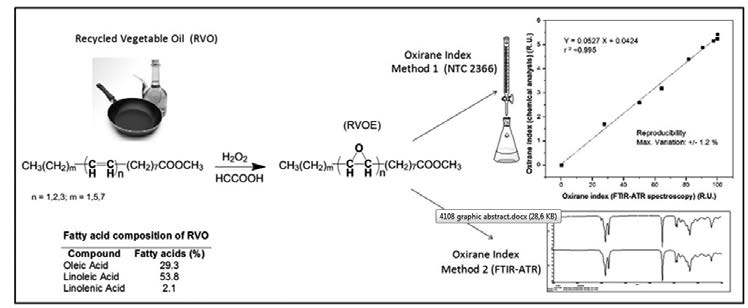FAST AND RELIABLE METHOD FOR MONITORING EPOXIDATION REACTION IN RECYCLED VEGETABLE OILS (ERVO) USING FTIR-ATR TECHNIQUE
- Ftir-atr technique,
- Monitoring epoxidation
Copyright (c) 2016 Christian Núñez, Emilio Vergara, Justo Lisperguer, Cynthia Droguett

This work is licensed under a Creative Commons Attribution-ShareAlike 4.0 International License.
Abstract
Recycled oils had been a viable alternative for the generation of biodiesel and higher value-added derivatives. Among these derivatives are also bioplasticizers for polymers. Vegetable oils provide a sustainable alternative for plasticizers manufacture, due to the presence of their unsaturation a chemical modification by an epoxidation reaction is possible. Moreover, the use of recycled oils for bioplastificizers preparation is cheaper and profitable. However since it is a complex mixture of vegetable oils, prior characterization of the fatty acids variety making up the mixture to generate bioplasticizer is necessary. Costs associated with monitoring of these kinds of reactions are usually high.

References
- -V. Goud, A. Patwardhan, S. Dinda, S. Pradhan. Eur. J. Lipid Sci. Tech. 109:575–584, (2007).
- -C. Nuñez, E. Vergara, W. Gacitúa, P. Valenzuela. XXX Jornadas Chilenas de Química. Libro Resumen. Pag. QM312. (2013).
- -S. Anuar, Y. Zhao, S. Mugo, J. Curtis. J. Am. Oil Chem. Soc. November 2012, 89(11): 1951-1960, (2012).
- -J. Ochoa (coord.). Industria quimica basada en biomasa implicaciones tecnológicas. Informe. Final 2007. Fundación LEIA CDT por encargo de Observatorio Químico del MICYT (2007). 105 pag.
- -I. Homer, F. Ruiz, M. Sanchez, P. Calandra. VII Congreso Iberoamericano de Agroingeniería y Ciencias Hortícolas. Madrid, 26-29. Agosto 2013. (2013).
- -M. Vieira, M. da Silva, A. Maçumoto, L. Santos, M. Beppu. Mat. Res. Vol.17, n.2, pp. 386-391, (2014).
- -T. Saurabh, M. Patnaik, S. Bhagt, V. Renge. International Journal of Advanced Engineering Technology. Vol.II/Issue IV/October-December, 491-501, (2011).
- -B. M. Abdullah, J. Salimon. J. Appl. Sci. 10(15):1545–1553, (2010).
- -M. Milchert, A. Smagowicz, G. Lewandowski. J Chem. Technol. Biotechnol. 85:1099–1107, (2010).
- -M-C. Kuo, T-C. Chou. Ind Eng Chem Res 26(2):277–284, (1987).
- -M. Rüsch gen. Klaas, S. Warwel. Ind. Crops Prod., 9, 125–132, (1999).
- -M. Guillen, N. Cabo. Food Chem. 77: 503-510, (2002).
- -D. Goburdhun, S. Jhaumeer-Laulloo, R. Musruck. Int. J. Food Sci. Nutr. 52 (1) 31-42, (2001).
- -Y. Zhang, Y. Zhang, X. Chen, Y. Zhang. Reactive & Functional Polymers 47. 93-99, (2001).
- -N. Vlachos, Y. Skopelitis, M. Psaroudaki, V. Konstantinidou, A. Chatzilazarou, E. Tegouet. Analytica Chimica Acta, 573–574: 459–465, (2006).
- -ICONTEC. NCT 2366. Aceites vegetales epoxidados de soya y linaza. 11 pag, (2000).
- -ICONTEC. NTC 3305. Plásticos. Muestreo y evaluación de los plastificantes utilizados en plásticos. 8 pag, (1997).
- -L. Boyacá, A. Beltrán. Ingeniería e Investigación 30(1):136-40, (2010).
- -J. Espinoza, D. Haagenson, S. Pryor, C. Ulven, D. Wiesenborn. Transactions of the ASABE. 52(4): 1289-1297, (2009).


